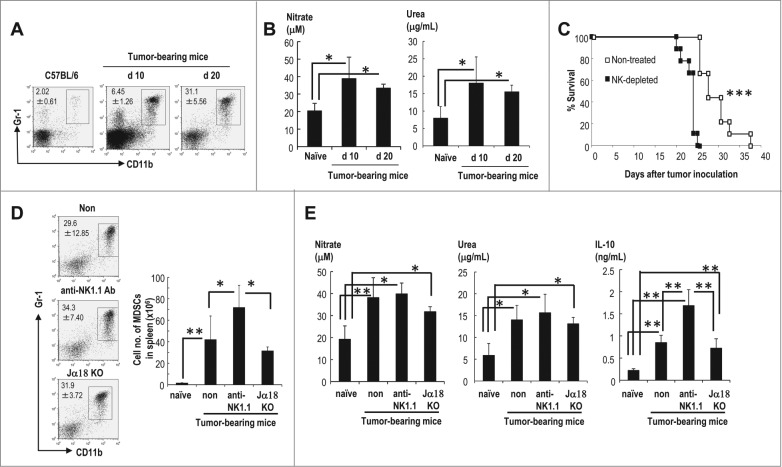Figure 2.
MDSCs capable of producing IL-10 are increased in NK cell-depleted EL4 lymphoma-bearing mice. C57BL/6 (WT) mice were injected subcutaneously (s.c.) with EL4 lymphoma cells. (A) The percentages of CD11b+Gr1+ MDSCs in spleen on d 10 and 20 were analyzed using Gr1-APC and CD11b-FITC (n = 4–6, mean ± SEM). (B) The arginase activity (right) and NO production (left) of the sorted CD11b+Gr1+ splenic MDSCs were analyzed on day 10 and 20 after EL4 inoculation (n = 4–7, mean ± SEM; *p < 0.05). (C) The survival of EL4-bearing WT or NK cell-depleted mice was assessed. The survival curves were plotted using Kaplan–Meier estimates and compared through long-rank analysis (n = 9 per group; ***p < 0.001). (D) The frequencies of CD11b+Gr1+ MDSCs in tumor-bearing WT, anti-NK1.1 Ab-treated mice, and Jα18-KO mice on day 20 were analyzed by FACS (left). The total numbers of CD11b+Gr1+ splenic MDSCs in these animals were assessed 20 d after tumor inoculation (right; n = 4–6, mean ± SEM; **p < 0.01, *p < 0.05). (E) The activities of NO (left) and arginase (middle) and the production of IL-10 (right) by splenic MDSCs were assessed in these animals on day 20 (n = 4–6, mean ± SEM; **p < 0.01, *p < 0.05).

